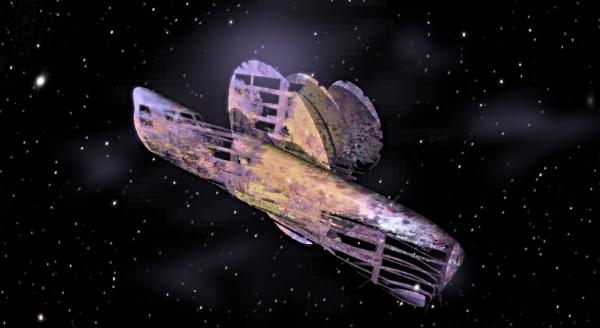BY LETTER
Unnamed species: HIE636MZE
 Image from Steve Bowers | |
| The first relic of HIE636MZE ever discovered was a fragment of an unmanned probe found in the Epsilon Sculptoris system | |
The first indisputable physical relic of an alien civilisation capable of extraplanetary activity, discovered in orbit around Epsilon Scuptoris A in 1460 AT by a First Federation Exploration mission.
The inactive remains of an autonomous vessel of exotic design were dated by a variety of methods to around two hundred million years bp. Since that time many similar remains have been found, and the story of the ancient race that built them has been slowly pieced together. This species has been assigned the label HIE636MZE by the Hamilton Institute.
To date, artifacts from this period have been found in 27 systems in the Terragen Sphere. After contact with the Muuh civilisation was established, a large body of historical and mythological data concerning ancient events has become available, and historians have built up a tentative picture of galactic events from the period when the HIE636MZE civilisation rose and fell.
196 million years ago, when HIE636MZE was at its greatest extent, it was apparently wiped out by an aggressive swarm of autonomous self-replicating factory-ships of its own creation. For over 18,000 years the swarm expanded, scouring hundreds of star systems for resources and impinging on the teritory of several other species.
Five other alien civilizations are believed to have existed in the same galactic arm at the time of this event. Three of them were related, being evolved from a single species (which has been given the designation HIE634MZE). These three civilisations had split from the original empire in some sort of ideological civil war a quarter of a million years before.
Four of these civilizations attempted to design defenses against the self-replicating swarm; one of the ex-colonies did not have the necessary skills and was forced to undertake a mass exodus ranging over 7,000 light years.
The resulting war involved several different automated fleets equipped with advanced weapons converging on each other and on the replicating swarm. It is suggested by some historians that these converging fleets were the original Dawn Hunter autowars, or perhaps were responsible for the later legends.
Each fleet had a different method and plan, and as a result came into conflict themselves, not recognizing the other fleets as valid allies. The five-way war lasted over 3,000 years, eradicating the original replicating swarm and the weakest of the four fleets, while the remaining three fleets entered a stalemate. Meanwhile, their respective biological creators refused any contact to avoid contamination. Eventually one of these races (an enigmatic civilization given the designation HIE637MZE) evolved into trickster-gods and then disappeared, a second stagnated, lost the ability to maintain its technology and degenerated into sub-sapients on several worlds, and the third apparently uploaded all their memories into a time-capsule which was supposed to awaken them and construct new bodies for them millions of years later (this has not been found).
Most of this story has been pieced together from stories and quasi-historical tales inherited by the Muuh from yet another ancient race. Almost nothing remains of these diverse civilisations, but fragmentary ruins of the mobile nanofactory-ships remain and have been extensively studied.
Related Articles
Appears in Topics
Development Notes
Text by Aaron Hamilton, updated by Steve Bowers
Initially published on 02 July 2000.
Initially published on 02 July 2000.






